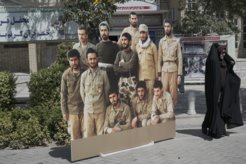The Pragmatics of Martyrdom
The Political Efficiency of Sacrificial Death in Post-Revolutionary Iran
Parand Danesh

This dissertation uses a multidisciplinary approach to explore the political value and symbolic efficiency of sacrificial death (martyrdom) in Shia culture in post-revolutionary Iran.
In 1979, the Islamic Revolution assigned a new meaning to the act of sacrificial death as the preservation of sacred values on which it relied. Although protesters on the side of Khomeini who died at the hands of the Shah's armed forces only had in common their opposition to the monarchical regime and to Western imperialism, all were integrated into one official category: "martyrs of the revolution", a notion widely popularized through Khomeini’s speeches. Then, from 1980 to 1988, prototypical portraits of the "martyrs of the Iran-Iraq war", painted on building facades all over the country, were institutionalized and spread on an even larger scale. An official “war culture” took shape, disconnected from the plurality and the very subjective combat experiences of the soldiers. The act of martyrdom soon became the matrix of a new radicalized civilian community and very rapidly invaded and appropriated public space. The plurality of revolutionary aspirations was erased in order to neutralize contestation. The official martyr has since become a form of political currency and a tool intended to guarantee the sovereignty of a repressive state in constant need of legitimacy.
The iconography of the martyr, superimposed for more than four decades, is not, however, a unified and homogenous category. Multiple forms of martyrdom cohabitate in the Iranian political and urban landscape, each of which gather around them an affective community that generates political dissensions and polarized expressions of what could be referred to as "national identity".
